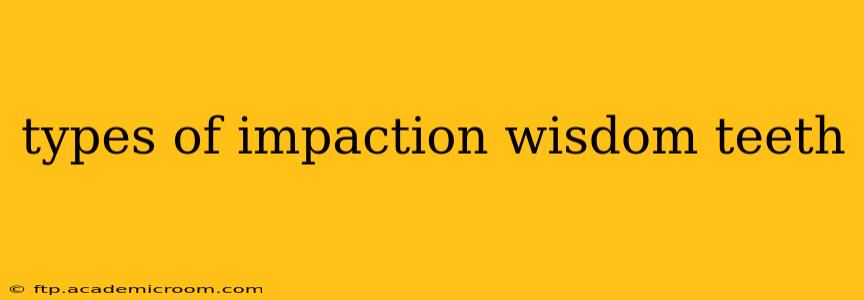Wisdom teeth, also known as third molars, are the last teeth to erupt in the mouth, typically appearing between the ages of 17 and 25. However, they often lack the space needed to emerge fully, resulting in impaction. Understanding the different types of impacted wisdom teeth is crucial for proper diagnosis and treatment planning. This guide explores the various classifications of impacted wisdom teeth, detailing their characteristics and potential complications.
What are Impacted Wisdom Teeth?
Before diving into the types, let's define impacted wisdom teeth. An impacted tooth is one that is prevented from fully erupting through the gum line. This can be due to a lack of space in the jaw, overlying bone, or adjacent teeth blocking its path. Impaction can lead to various problems, including pain, infection, and damage to nearby teeth.
Types of Impacted Wisdom Teeth: A Detailed Look
Impacted wisdom teeth are categorized based on their position relative to the adjacent second molar and the angle of their eruption. The most common classification system uses four categories:
1. Partially Impacted Wisdom Teeth
A partially impacted wisdom tooth is only partially erupted through the gum line. A portion of the crown (the visible part of the tooth) might be visible, while the rest remains covered by gum tissue. This type of impaction can still lead to problems like pericoronitis (infection of the gum tissue surrounding the partially erupted tooth). It's important to note that even partially erupted wisdom teeth can cause significant issues and may require extraction.
2. Fully Bony Impacted Wisdom Teeth
In this type of impaction, the wisdom tooth is completely covered by gum tissue and bone. It is entirely submerged and hasn't begun to erupt at all. Fully bony impactions are often more challenging to remove surgically and may necessitate a more complex extraction procedure. The difficulty of removal depends on the depth of impaction and the surrounding bone structure.
3. Soft Tissue Impacted Wisdom Teeth
Here, the wisdom tooth is covered by gum tissue but not by bone. The tooth may be angled, preventing it from breaking through the gum. This type of impaction can still cause problems like infection and inflammation. Soft tissue impactions are generally easier to remove than fully bony impactions, often requiring simpler surgical techniques.
4. Mesioangular Impacted Wisdom Teeth
This refers to the angle of the wisdom tooth's eruption. In a mesioangular impaction, the wisdom tooth is tilted forward, towards the second molar. This is one of the most common types of impaction. The angle of impaction significantly influences the surgical approach needed for removal.
5. Distoangular Impacted Wisdom Teeth
In contrast to mesioangular impaction, a distoangular impaction sees the wisdom tooth tilted backward, away from the second molar. This type of impaction is less common than mesioangular impaction.
6. Horizontal Impacted Wisdom Teeth
As the name suggests, the tooth lies horizontally within the jawbone, completely blocked from erupting. This is a common type of impaction and often requires surgical removal.
7. Vertical Impacted Wisdom Teeth
These wisdom teeth are positioned vertically in the jawbone but are still prevented from fully erupting, typically due to lack of space. While vertically impacted teeth appear to be in the correct position, they still might cause problems and potentially require extraction.
What are the Symptoms of Impacted Wisdom Teeth?
Symptoms of impacted wisdom teeth can vary depending on the type and severity of the impaction, but common signs include:
- Pain: This can range from mild discomfort to severe throbbing pain.
- Swelling: The gums around the impacted tooth may become swollen and tender.
- Infection (pericoronitis): This is a common complication characterized by inflammation and infection of the gum tissue surrounding the partially erupted tooth.
- Bad Breath: Bacteria trapped around the impacted tooth can lead to bad breath.
- Difficulty Opening Mouth: Severe impaction can restrict jaw movement.
- Jaw Pain or Stiffness: Discomfort may spread beyond the affected area.
When Should I See a Dentist About Impacted Wisdom Teeth?
If you experience any of the above symptoms or suspect you might have impacted wisdom teeth, it's essential to consult a dentist or oral surgeon. Early diagnosis and treatment can help prevent more serious complications. Regular dental checkups are also vital to monitor the development and position of your wisdom teeth.
Conclusion
Understanding the different types of impacted wisdom teeth is crucial for effective diagnosis and treatment. Each type presents unique challenges, influencing the approach an oral surgeon might take during extraction. Always consult a dental professional for accurate assessment and personalized treatment planning. Early intervention can often prevent more significant problems in the future.
